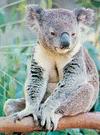- koala
-
/koh ah"leuh/, n.a sluggish, tailless, gray, furry, arboreal marsupial, Phascolarctos cinereus, of Australia.[1800-10; erroneous sp. for earlier koola(h) (now obs.) < Dharuk gú-la]
* * *
About 24–33 in. (61–85 cm) long and tailless, the koala has a stout, pale gray or yellowish body; broad face; big, round, leathery nose; small, yellow eyes; and fluffy ears. Its feet have strong claws and some opposable digits. The koala feeds only on eucalyptus leaves. The single offspring remains in the rearward-opening pouch for up to seven months. Koala populations have dwindled seriously, formerly because they were killed for their fur and now because of loss of habitat and the spread of disease. Koala (Phascolarctos cinereus).Anthony Mercieca from The National Audubon Society Collection/Photo Researchers
Koala (Phascolarctos cinereus).Anthony Mercieca from The National Audubon Society Collection/Photo Researchers* * *
also called koala beartree-dwelling marsupial of coastal eastern Australia. The koala is about 60 to 85 cm (24 to 33 inches) long and weighs up to 14 kg (31 pounds) in the southern part of its range (Victoria) but only about half that in subtropical Queensland to the north. Virtually tailless, the body is stout and gray, with a pale yellow or cream-coloured chest and mottling on the rump. The broad face has a wide, rounded, leathery nose, small yellow eyes, and big fluffy ears. The feet are strong and clawed; the two inner digits of the front feet and the innermost digit of the hind feet are opposable for grasping.The koala feeds very selectively on the leaves of certain Eucalyptus trees. Generally solitary, individuals move within a home range of more than a dozen trees, one of which is favoured over the others. If koalas become too numerous in a restricted area, they defoliate preferred food trees and, unable to subsist on even closely related species, decline rapidly. To aid in digesting as much as 1.3 kg (3 pounds) of leaves daily, the koala has an intestinal pouch ( cecum) about 2 metres (7 feet) long, where symbiotic bacteria degrade the tannins (tannin) and other toxic and complex substances abundant in eucalyptus. This diet is relatively poor in nutrients and provides the koala little spare energy, so the animal spends long hours simply sitting or sleeping in tree forks, exposed to the elements but insulated by thick fur. Although placid most of the time, koalas produce loud, hollow grunts.The koala is the only member of the family Phascolarctidae. Unlike those of other arboreal marsupials, its pouch opens rearward. Births are single, occurring after a gestation of 34 to 36 days. The youngster (called a joey) first puts its head out of the pouch at about five months of age. For up to six weeks, it is weaned on a soupy predigested eucalyptus called pap that is lapped directly from the mother's anus. Pap is thought to be derived from the cecum. After weaning, the joey emerges completely from the pouch and clings to the mother's back until it is nearly a year old. A koala can live to about 15 years of age in the wild, somewhat longer in captivity.Formerly killed in huge numbers for their fur, especially during the 1920s and '30s, koalas dwindled in number from several million to a few hundred thousand. In the southern part of their range, they became practically extinct (extinction) except for a single population in Gippsland, Victoria. Some were translocated onto small offshore islands, especially Phillip Island, where they did so well that these koalas were used to restock much of the original range in Victoria and southern New South Wales. Though once again widespread, koala populations are now scattered and separated by urban areas and farmland, which makes them locally vulnerable to extinction. Another problem is the infection of many populations with Chlamydia, which makes the females infertile.* * *
Universalium. 2010.
